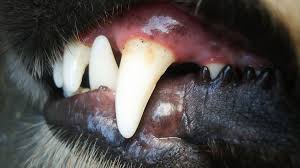
One of the first significant problems I tried to address with Georgie’s health was his poor dental condition. Due to his discomfort in eating, I needed to position his food in a bowl so that he could basically scoop it out with his lips. He couldn’t get to the bottom of his food bowl so I needed to feed him the last portion of every meal by hand. Many of his teeth were barely visible above his inflamed gum line and some of his front teeth had been ground down to near the gum line. His breath was constantly foul, he had tartar on all of the visible surfaces of his teeth, and his gum would start bleeding any time he tried chewing which he tried to avoid. He avoided trying to pick up any items by mouth and I could tell that even though he was overweight and tried to get as many calories as he could, the process of eating itself was painful. In order for me to get his diet on track, I felt the first order was to try to get his oral hygiene and inflammation under control.
My approach was to use the same techniques I had used personally to improve my own dental health. As part of researching probiotics use for alleviating symptoms of inflammatory bowel disease in my granddaughter, who has ulcerative colitis, I came upon some interesting studies that had shown certain beneficial gut bacteria to be effective in improving dental health. Beneficial bacteria and other microorganisms living in the intestinal tract have a large role in disease protection as well as contributing to digestive function. One of the ways that microorganisms help with inflammatory bowel disease in humans is by lining the digestive tract with a protective mucous barrier. When the mucous barrier is broken down, for example by antibiotics use, a bacterial imbalance can occur which leads to inflammation and improper nutrient absorption and can result in diarrhea and a host of other problems. The same thing happens with dogs. An interesting learning point for me was that Lactobacillus strains are not only beneficial in gut health but also in dental health. While the gut gets most of the attention with probiotics use, the mouth is also an area that is rich in beneficial microorganisms when the microbiome is balanced. The microorganisms that colonize the mouth seed the gut. If the mouth isn’t healthy, really nothing else is.
I found research about Lactobacillus reuteri and its positive effects in humans. It is a common friendly bacterium that naturally occurs in mammals and birds. Most of the research points to the beneficial effects of the organism in gut health and promoting overall wellness. It got a little confusing when trying to determine which strains are appropriate for different organisms like humans versus other animals but with a little more digging found that some positive research results in dogs were found in gut health studies using VSL 3, which is a medical probiotic preparation used by people, including my granddaughter, for inflammatory bowel disease. That, coupled with the fact that that all strains of L. reuteri produce a broad spectrum antibiotic substance known as reuterin that inhibits the growth of some harmful bacteria, yeasts, and other microbes convinced me to try a readily available commercial strain used as a probiotic for humans. L. reuteri has been shown to kill Streptococcus mutans, a bacteria responsible for tooth decay and in studies with humans afflicted with gingivitis, use of L. reuteri as an oral delivery showed decreased gum bleeding, plaque formation and other symptoms. Much of the research on dental health centers on determining the clinical benefit of using probiotics in the treatment of periodontal disease and the actual design of some of the studies do not allow conclusions to be made in terms of the dose and other methodology, so for Georgie, I decided to use an easily available product that would allow the L. reuteri to be introduced orally and repeatedly. I started with Nature’s Way Primadophilus Reuteri at a dose of 5 billion CFU a day sprinkled on his morning feeding which consisted of 1 cup of Iams Healthy Weight Formula dry food mixed with ½ can of Purina One wet food.
Within a few weeks, Georgie’s gum inflammation had noticeably improved and he no longer had any visible bleeding with chewing. His ability to eat was much more comfortable and normal. He started being able to finish his whole ration without having to try to scoop food with his lips and he began to pick up tennis balls and other objects. Where he had previously been very reluctant to chew anything, he now wanted to chew. His breath was no longer foul and his overall physical condition was much improved. The amount of plaque and tartar was visibly reduced. Now that he was able to function more normally, I decided to try to help him get rid of as much of the remaining plaque and tartar as possible by giving him a gentle brushing twice a week along with a commercial soft dog dental chew with enzymatic toothpaste on it. I didn’t want to overdo the brushing since he didn’t care for it and I had also read that the whole idea of removing a healthy biofilm by brushing it off or otherwise aggressively cleaning was being viewed as counterproductive by many experts, especially those who favor treating dental disease with probiotics. I was certainly happy with Georgie’s progress and when I took him to the veterinarian (the same vet who had evaluated him right before I adopted him) for immunizations after only about six weeks, she was quite impressed with the difference not only in his dental health but with his overall health as well.